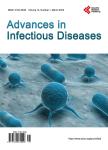Melioidosis an Imported Infection in Qatar: Case Series and Literature Review
Melioidosis an Imported Infection in Qatar: Case Series and Literature Review作者机构:Infectious Disease Division Department of Medicine Hamad General Hospital Doha Qatar Radiology Department Hamad General Hospital Doha Qatar Microbiology Department University Hospital Coventry and Warwickshire NHS Trust Coventry UK
出 版 物:《Advances in Infectious Diseases》 (传染病进展(英文))
年 卷 期:2022年第12卷第2期
页 面:175-192页
学科分类:1002[医学-临床医学] 100214[医学-肿瘤学] 10[医学]
主 题:Melioidosis Bactraemic Abactraemic Melioidosis Burkholderia pseudomallei Infection
摘 要:Introduction: Melioidosis is a tropical infectious disease caused by Gramnegative bacteria Burkholderia pseudomallei (B. pseudomallei). This soil-borne disease is endemic in Southeast Asia and Northern Australia. In our country it was reported once before in 2000 in a patient who presented with subdural empyema. Case Series Report: We are reporting six cases of Melioidosis presented to our hospital in very close time with different clinical presentations. All patients were from Indian subcontinent. In 3 cases we treated with Meropenem plus Trimethoprim-Sulfamethoxazole (TMP-SMX) followed by oral TMP-SMX and Doxycycline for around 6 months with good clinical and radiological response, while the fourth case was treated with oral TMP-SMX and Doxycycline for 1 month but he lost to follow up, the Fifth cases were treated with IV Ceftazidime followed by TMP-SMX and Doxycycline for 9 weeks, the Sixth cases were treated with IV Ceftazidime followed by TMP-SMX and Amoxicillin/Clavulanic acid for 20 days, there was no mortality reported in our case series for both types Bactraemic and Abactraemic Melioidosis. Conclusions: This case series highlights the importance of early identification of B. pseudomallei which requires a high index of clinical suspicion as well as good understanding of demographical and travel history. Microbiological identification of B. pseudomallei is essential and requires notification of the microbiologist for suspicion of that infection. Prolonged antimicrobial therapy is required for a better clinical outcome.



